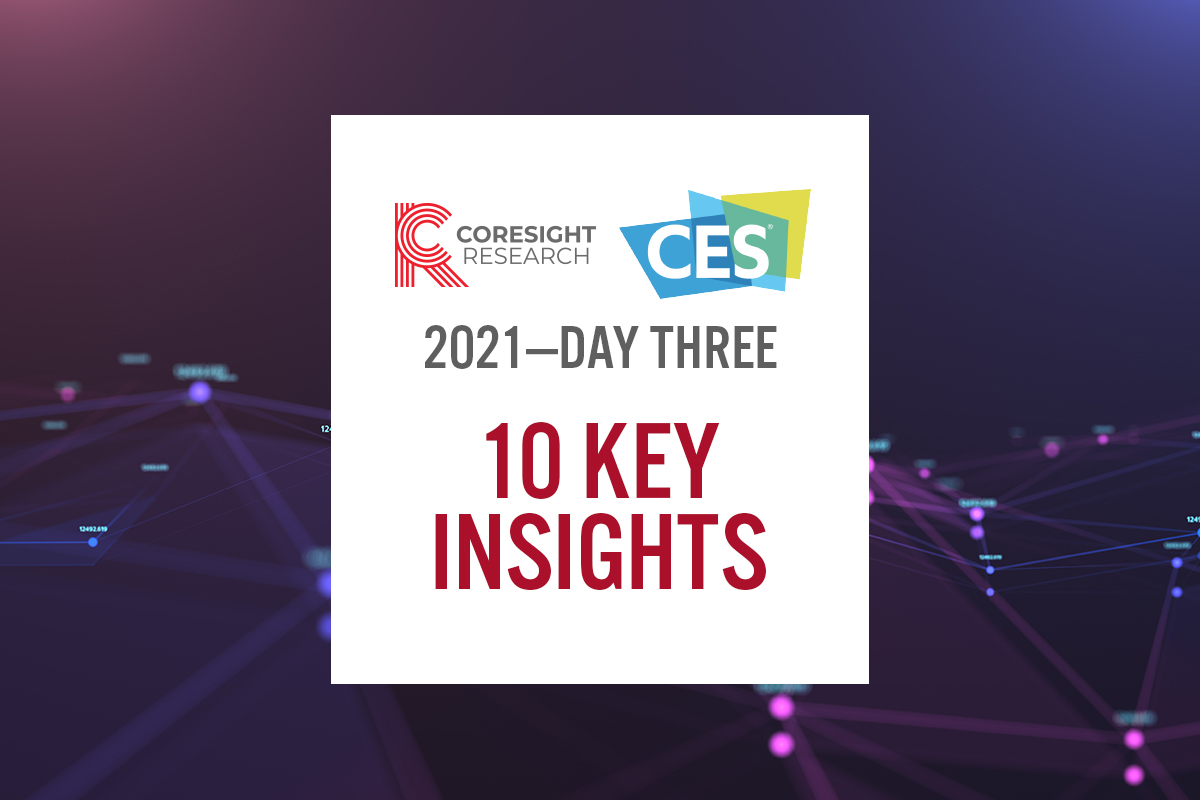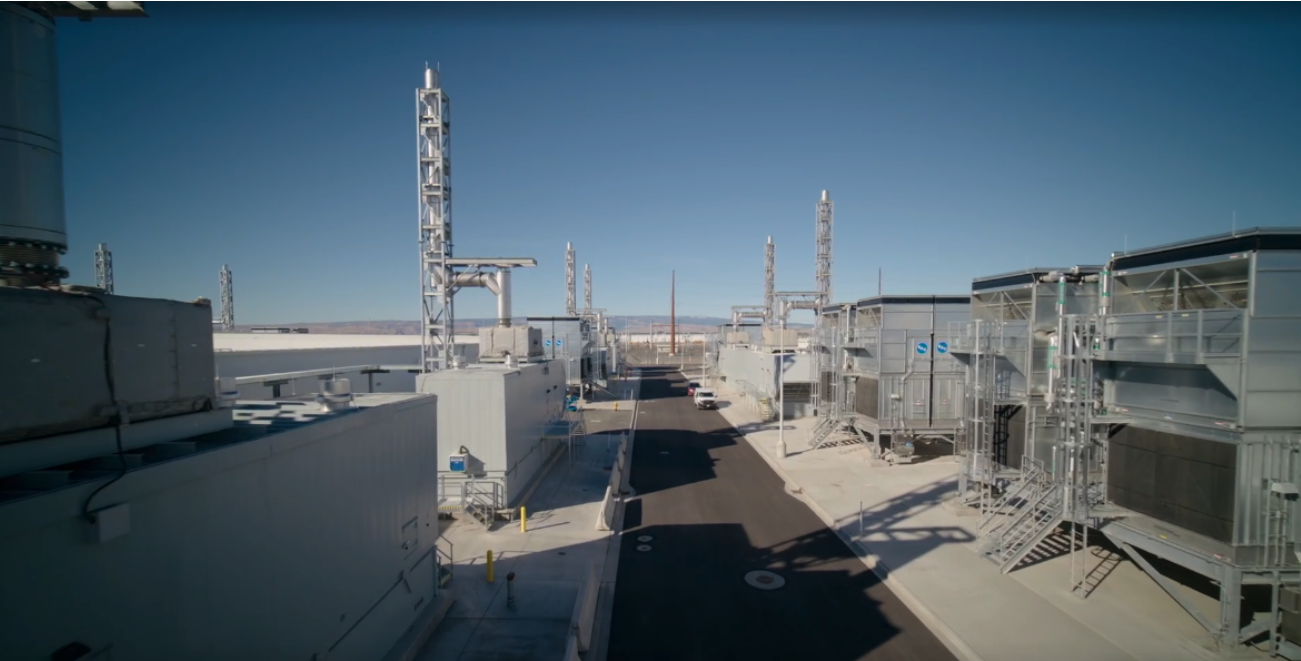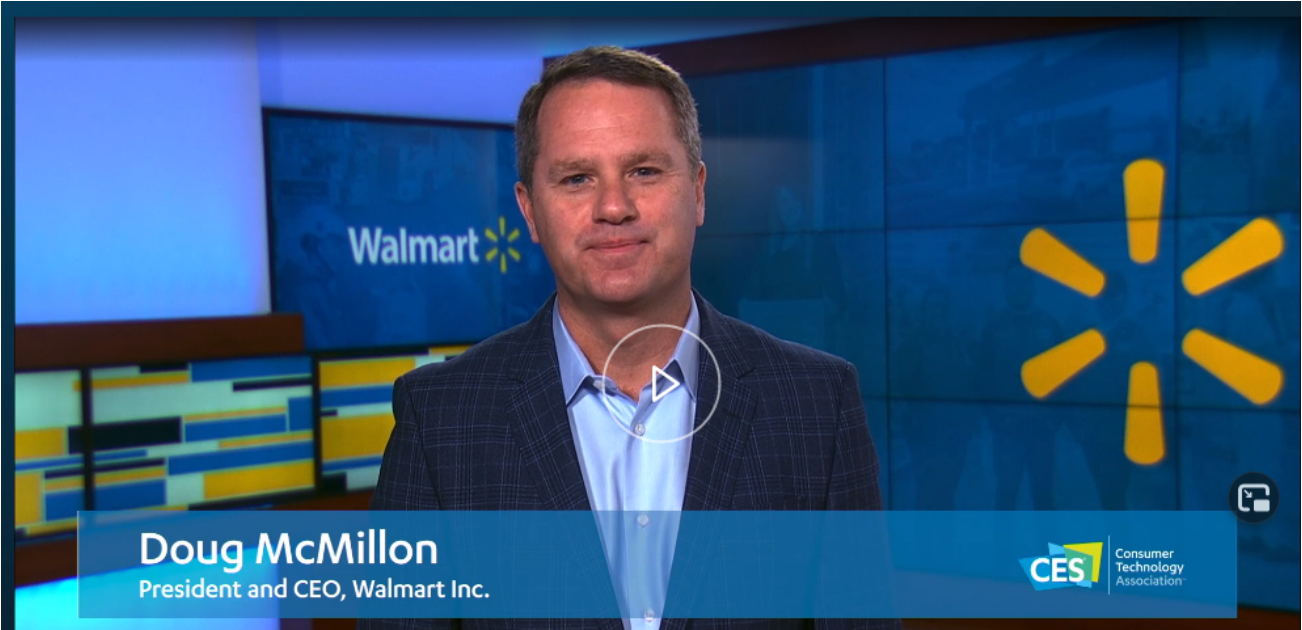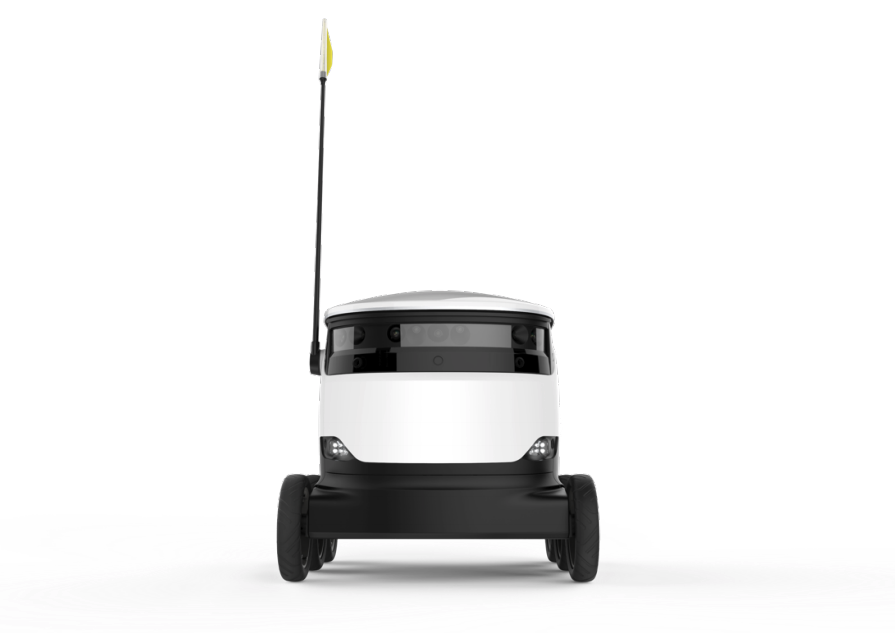
Nitheesh NH
CES 2021, an event held by the Consumer Technology Association (CTA), took place on January 11–14 and was a virtual event for the first time. Key tech trends at this year’s CES included digital health, robotics and drones, 5G connectivity, digital transformation, vehicle technology and smart cities.
The Coresight Research team presented our takeaways from day one and day two of the event in separate reports. In this report, we offer our closing thoughts on the event as a whole, as well as 10 key insights from day three.
 Columbia data center
Columbia data center
Source: Microsoft[/caption] 2. There Are Areas for Future Improvement of Technology in the Supply Chain While Walmart has long been a leader in managing its supply chain, President and CEO Doug McMillon emphasized the importance of driving progress in the future, putting technology such as software, data and robotics to work at an accelerated rate. Although he acknowledged that retailers face challenges in forecasting demand, Smith said that technology can be effectively employed at distribution centers to improve stock levels and inventory management. Retailers can also adopt AI and 5G to improve the consumer journey and enhance personalization. That said, McMillon highlighted issues surrounding technology, primarily data security—it is critical that retailers preserve customers’ trust and never surprise them as to how their data is being used. 3. An Omnichannel Approach to Healthcare Is Emerging Healthcare has been important to Walmart for some time, with the company hosting pharmacy and optical services in its stores. Walmart entered the patient market by providing urgent care clinics but has since pivoted to providing preventative care and aims to do so in a way that is transparent and not intimidating. Walmart has been opening Walmart Health Clinics in the US over the past two years—first in Georgia, then Chicago and Arkansas—with plans for many more. McMillion outlined the company’s “omnichannel approach” to healthcare—employing in-person services alongside data capabilities and digital technologies. To operate this model effectively, Walmart employs a chief medical officer. 4. Walmart Reconfigures Its Business To Achieve Racial Equity Walmart already had its own diversity and equity programs, but the events of 2020 presented opportunities to be more bold and aggressive in its initiatives. Management is now holding the more-difficult conversations about race and conducting employee training in a different way, according to the company. Walmart is focusing on the elements that result in inequity and making changes to its promotion and pay processes to redress the balance. Walmart is also conducting mid-year reviews of these processes that aim to provide an honest assessment of progress and the areas lacking progress. Steps toward progress involve talking and listening to employees, having engaged and open conversations and setting clear objectives. Walmart stated that diverse and inclusive teams have been shown to be more successful. [caption id="attachment_121757" align="aligncenter" width="700"] CEO Doug McMillon, President and CEO at Walmart, speaks at CES 2021
CEO Doug McMillon, President and CEO at Walmart, speaks at CES 2021
Source: CTA[/caption] 5. Many of the Most Compelling Applications of 5G Are Yet To Be Imagined The CES 2021 panel entitled “Trends in Mobile Communications” featured speakers from Samsung Electronics America and Ice Mobility, which offers supply chain solutions. Last year was an inflection point in the rollout of 5G networks, following the initial deployment of the technology in 2018. New applications are yet to be imagined and will derive from the combination of speed, low latency (the time required to connect to the network) and high bandwidth that 5G provides. For consumers, 5G use cases include “better on 5G” and “only on 5G” experiences. Better 5G experiences include full-HD video chat and cloud gaming. Exclusive 5G applications include in-stadium experiences—using augmented reality with statistics overlaid on video from the field. New exclusive applications will emerge in the future. 5G will evolve as the becomes more pervasive geographically and as technologies offer benefits from the new network. Its low latency will enable the creation of many more real-time data services, such as 360-degree information around the device, vehicle or home, which will drive new capabilities and accessibility. 6. Consumers Are Rapidly Embracing Fintech and E-Banking This Year The panel entitled “The Rise of FinTechs – Has Consumer Financial Behavior Changed Forever” featured speakers from financial service companies Plaid and Stripe. The Covid-19 pandemic has accelerated the move to e-commerce and e-banking by at least five years. In digital banking, a survey commissioned by Plaid—which provides a data network for connecting apps, services and enterprises—found that 60% of US consumers are using more apps to manage their money than they did before the pandemic, and 80% of Americans feel that they can completely manage their financial lives without ever having to enter a bank. These views dramatically change focus areas for financial services in the future. Consumer interest has grown this year in investing applications and in neo-banks. Small businesses are also banking customers, and policies like PPP (the payroll protection program) proved quite complex for companies, requiring legacy devices like fax machines and suggesting the need for more automated financial transactions. Stripe was founded to help businesses accept payments online, with companies having to add just seven lines of code to their websites to accept online payments. According to the company, nearly 90% of adults in the US made a purchase on Stripe (which is largely invisible to users) last year, including via mobile payments and “buy now, pay later” platforms. The company has moved beyond payments—for example, Stripe Capital helps businesses access capital to smooth out their cash flow, and partners can offer these services to their customers. 7. Robots Take On New Tasks and Offer Cheaper, More Sustainable Delivery In one CES 2021 session on day three, a panel featuring speakers from Intel, robot maker Starship Technologies and drone-delivery company Wing discussed the evolution of robotics and emerging applications. With all the changes in 2020, the scope of tasks originally envisioned for robots—such as working in dirty or dangerous environments—expanded to include sanitizing factories, hospitals, offices and vehicles. Moreover, consumers increasingly demanded contactless delivery in light of the Covid-19 pandemic, which tripled sales volumes for Starship Technologies in 2020. There was much discussion surrounding the economics of present-day delivery and the costs and pollution associated with traditional vehicles. Automated robotics offers significant potential for reducing costs in the last mile, as well as providing a sustainable solution, which offers benefits for both consumers and merchants. In addition, drones benefit from the rapid innovation that consumer-electronics product cycles enable. Technical challenges for fleets of autonomous vehicles include managing an enormous amount of data and operating outdoors in adverse weather conditions. [caption id="attachment_121758" align="aligncenter" width="420"] Autonomous delivery vehicle
Autonomous delivery vehicle
Source: Starship Technologies[/caption] 8. Contactless Payment Gains Traction and Enhances the Shopping Journey The panel entitled “The Future of Contactless Shopping” featured speakers from Visa, Jetson AI, MagicCube and Standard Cognition. Despite its recent surge in popularity, contactless shopping technology—reducing human contact in the in-store journey—is not a new concept; it has seen deployment over the past 10 years. Standard Cognition, a company that provides AI-powered autonomous checkout technology, believes that computer vision is the future of retail. Although the sharp increase in the adoption of contactless technologies has been driven by the pandemic, the company believes that this evolution was inevitable. Machines should perform the tasks they do best—taking inventory, counting money, preventing shrinkage, collecting data and performing analytics—while humans can focus on what they do best: forming relationships. One computer vision application is “walk in and walk out,” meaning that the customer does not need to use checkout terminals in stores. Demonstrating the popularity of contactless payment options among today’s consumers, three in four payments currently processed by Visa’s system worldwide are contactless. In addition to contactless payment services via smartphones, there are 255 million contactless cards in the US, according to Visa. In a study conducted by Visa, nearly two-thirds of surveyed consumers said they would switch to a new store that implemented contactless payment options. There are also nontraditional places where contactless payments could be revolutionary, such as in transit. One tool to improve contactless acceptance is Visa’s Tap to Phone, which is an app that enables users of an Android phone to accept payments. Software development company MagicCube offers i-Accept, a software-based replacement for traditional point-of-sale terminals that offers merchants an option for contactless and PIN payment acceptance through Android devices. Innovative applications of contactless technologies also include voice commerce. Jetson AI partners with enterprise companies to provide licensing and integration of voice-first solutions, implementing AI tools into existing operations. 9. The Cloud Enables Enterprises To Perform Rapid Testing and Experimentation Cloud technologies are revolutionizing business, according to speakers from Microsoft, professional services firm Accenture and the CTA. Accenture believes that in the Covid-19 environment, the cloud has moved from being a topic of interest to an important consideration for CEOs. It has become a transformational element for enterprises and business leaders in two ways:
CES 2021: Closing Thoughts
All of the major focus technologies at CES 2021—digital health, robotics and drones, 5G connectivity, digital transformation, vehicle technology and smart cities—had been announced in prior years, making the conference evolutionary, not revolutionary. This is the pattern of CES: Announce major technologies and spend the next several years developing applications for them. Technologies such as digital health, AI and robotics remain in their infancy and will likely generate many compelling application in the years to come. While it was disappointing for event attendees not to be able to experience the magic of Las Vegas in person this year, the virtual format worked quite well. In particular, the streaming format enabled viewers to pause sessions and replay them on their own schedule, eliminating the need to stand in line for press conferences (as well as taxis) and rushing between sessions. The technology worked well with no major glitches. We hope that the CTA will consider offering some or all sessions virtually next year.CES Day Three: 10 Key Insights
The third day of CES 2021 covered a number of technologies: 5G, robotics, fintech, contactless shopping, cloud computing and AI. It featured keynote addresses from Microsoft, on the promise and perils of technology, and Walmart, covering the use of technology to improve its business, its omnichannel approach to healthcare and the company’s efforts to improve inclusion and equality. 1. Technology Presents Promise and Perils—Humans Must Decide Its Uses Brad Smith, President at Microsoft Corporation, offered remarks on the promise and perils of technology.- Perils: Smith referenced the 1980’s movie War Games, in which someone believes he is logging into a US government system to play a game but rather initiates a military crisis—a situation that is uncomfortably realistic. Recent real-life perils include the recent Solar Winds hacking attack, which represented an attack on the technology industry and violated previous behavior norms. Moreover, technologies such as AI and facial recognition offer convenience for consumers but offer their own unique risks and perils if the technology is abused.
- Promise: Smith offered a video tour of Microsoft’s impressive Columbia cloud data center, which uses technology at the intersection of digital, energy, environment and innovation. If people work together, technology has the ability to unite humankind. Smith cited the moon landing in the 1960s as an example of a technology-empowered event that united humanity in a time of great social unrest.
 Columbia data center
Columbia data centerSource: Microsoft[/caption] 2. There Are Areas for Future Improvement of Technology in the Supply Chain While Walmart has long been a leader in managing its supply chain, President and CEO Doug McMillon emphasized the importance of driving progress in the future, putting technology such as software, data and robotics to work at an accelerated rate. Although he acknowledged that retailers face challenges in forecasting demand, Smith said that technology can be effectively employed at distribution centers to improve stock levels and inventory management. Retailers can also adopt AI and 5G to improve the consumer journey and enhance personalization. That said, McMillon highlighted issues surrounding technology, primarily data security—it is critical that retailers preserve customers’ trust and never surprise them as to how their data is being used. 3. An Omnichannel Approach to Healthcare Is Emerging Healthcare has been important to Walmart for some time, with the company hosting pharmacy and optical services in its stores. Walmart entered the patient market by providing urgent care clinics but has since pivoted to providing preventative care and aims to do so in a way that is transparent and not intimidating. Walmart has been opening Walmart Health Clinics in the US over the past two years—first in Georgia, then Chicago and Arkansas—with plans for many more. McMillion outlined the company’s “omnichannel approach” to healthcare—employing in-person services alongside data capabilities and digital technologies. To operate this model effectively, Walmart employs a chief medical officer. 4. Walmart Reconfigures Its Business To Achieve Racial Equity Walmart already had its own diversity and equity programs, but the events of 2020 presented opportunities to be more bold and aggressive in its initiatives. Management is now holding the more-difficult conversations about race and conducting employee training in a different way, according to the company. Walmart is focusing on the elements that result in inequity and making changes to its promotion and pay processes to redress the balance. Walmart is also conducting mid-year reviews of these processes that aim to provide an honest assessment of progress and the areas lacking progress. Steps toward progress involve talking and listening to employees, having engaged and open conversations and setting clear objectives. Walmart stated that diverse and inclusive teams have been shown to be more successful. [caption id="attachment_121757" align="aligncenter" width="700"]
 CEO Doug McMillon, President and CEO at Walmart, speaks at CES 2021
CEO Doug McMillon, President and CEO at Walmart, speaks at CES 2021Source: CTA[/caption] 5. Many of the Most Compelling Applications of 5G Are Yet To Be Imagined The CES 2021 panel entitled “Trends in Mobile Communications” featured speakers from Samsung Electronics America and Ice Mobility, which offers supply chain solutions. Last year was an inflection point in the rollout of 5G networks, following the initial deployment of the technology in 2018. New applications are yet to be imagined and will derive from the combination of speed, low latency (the time required to connect to the network) and high bandwidth that 5G provides. For consumers, 5G use cases include “better on 5G” and “only on 5G” experiences. Better 5G experiences include full-HD video chat and cloud gaming. Exclusive 5G applications include in-stadium experiences—using augmented reality with statistics overlaid on video from the field. New exclusive applications will emerge in the future. 5G will evolve as the becomes more pervasive geographically and as technologies offer benefits from the new network. Its low latency will enable the creation of many more real-time data services, such as 360-degree information around the device, vehicle or home, which will drive new capabilities and accessibility. 6. Consumers Are Rapidly Embracing Fintech and E-Banking This Year The panel entitled “The Rise of FinTechs – Has Consumer Financial Behavior Changed Forever” featured speakers from financial service companies Plaid and Stripe. The Covid-19 pandemic has accelerated the move to e-commerce and e-banking by at least five years. In digital banking, a survey commissioned by Plaid—which provides a data network for connecting apps, services and enterprises—found that 60% of US consumers are using more apps to manage their money than they did before the pandemic, and 80% of Americans feel that they can completely manage their financial lives without ever having to enter a bank. These views dramatically change focus areas for financial services in the future. Consumer interest has grown this year in investing applications and in neo-banks. Small businesses are also banking customers, and policies like PPP (the payroll protection program) proved quite complex for companies, requiring legacy devices like fax machines and suggesting the need for more automated financial transactions. Stripe was founded to help businesses accept payments online, with companies having to add just seven lines of code to their websites to accept online payments. According to the company, nearly 90% of adults in the US made a purchase on Stripe (which is largely invisible to users) last year, including via mobile payments and “buy now, pay later” platforms. The company has moved beyond payments—for example, Stripe Capital helps businesses access capital to smooth out their cash flow, and partners can offer these services to their customers. 7. Robots Take On New Tasks and Offer Cheaper, More Sustainable Delivery In one CES 2021 session on day three, a panel featuring speakers from Intel, robot maker Starship Technologies and drone-delivery company Wing discussed the evolution of robotics and emerging applications. With all the changes in 2020, the scope of tasks originally envisioned for robots—such as working in dirty or dangerous environments—expanded to include sanitizing factories, hospitals, offices and vehicles. Moreover, consumers increasingly demanded contactless delivery in light of the Covid-19 pandemic, which tripled sales volumes for Starship Technologies in 2020. There was much discussion surrounding the economics of present-day delivery and the costs and pollution associated with traditional vehicles. Automated robotics offers significant potential for reducing costs in the last mile, as well as providing a sustainable solution, which offers benefits for both consumers and merchants. In addition, drones benefit from the rapid innovation that consumer-electronics product cycles enable. Technical challenges for fleets of autonomous vehicles include managing an enormous amount of data and operating outdoors in adverse weather conditions. [caption id="attachment_121758" align="aligncenter" width="420"]
 Autonomous delivery vehicle
Autonomous delivery vehicleSource: Starship Technologies[/caption] 8. Contactless Payment Gains Traction and Enhances the Shopping Journey The panel entitled “The Future of Contactless Shopping” featured speakers from Visa, Jetson AI, MagicCube and Standard Cognition. Despite its recent surge in popularity, contactless shopping technology—reducing human contact in the in-store journey—is not a new concept; it has seen deployment over the past 10 years. Standard Cognition, a company that provides AI-powered autonomous checkout technology, believes that computer vision is the future of retail. Although the sharp increase in the adoption of contactless technologies has been driven by the pandemic, the company believes that this evolution was inevitable. Machines should perform the tasks they do best—taking inventory, counting money, preventing shrinkage, collecting data and performing analytics—while humans can focus on what they do best: forming relationships. One computer vision application is “walk in and walk out,” meaning that the customer does not need to use checkout terminals in stores. Demonstrating the popularity of contactless payment options among today’s consumers, three in four payments currently processed by Visa’s system worldwide are contactless. In addition to contactless payment services via smartphones, there are 255 million contactless cards in the US, according to Visa. In a study conducted by Visa, nearly two-thirds of surveyed consumers said they would switch to a new store that implemented contactless payment options. There are also nontraditional places where contactless payments could be revolutionary, such as in transit. One tool to improve contactless acceptance is Visa’s Tap to Phone, which is an app that enables users of an Android phone to accept payments. Software development company MagicCube offers i-Accept, a software-based replacement for traditional point-of-sale terminals that offers merchants an option for contactless and PIN payment acceptance through Android devices. Innovative applications of contactless technologies also include voice commerce. Jetson AI partners with enterprise companies to provide licensing and integration of voice-first solutions, implementing AI tools into existing operations. 9. The Cloud Enables Enterprises To Perform Rapid Testing and Experimentation Cloud technologies are revolutionizing business, according to speakers from Microsoft, professional services firm Accenture and the CTA. Accenture believes that in the Covid-19 environment, the cloud has moved from being a topic of interest to an important consideration for CEOs. It has become a transformational element for enterprises and business leaders in two ways:
- The cloud provides “elasticity” to governments and enterprises, enabling them to implement change as needed.
- It enables organizations to transform into innovation enterprises, which can create and launch new capabilities faster, by consuming cloud services rather than building them from scratch.